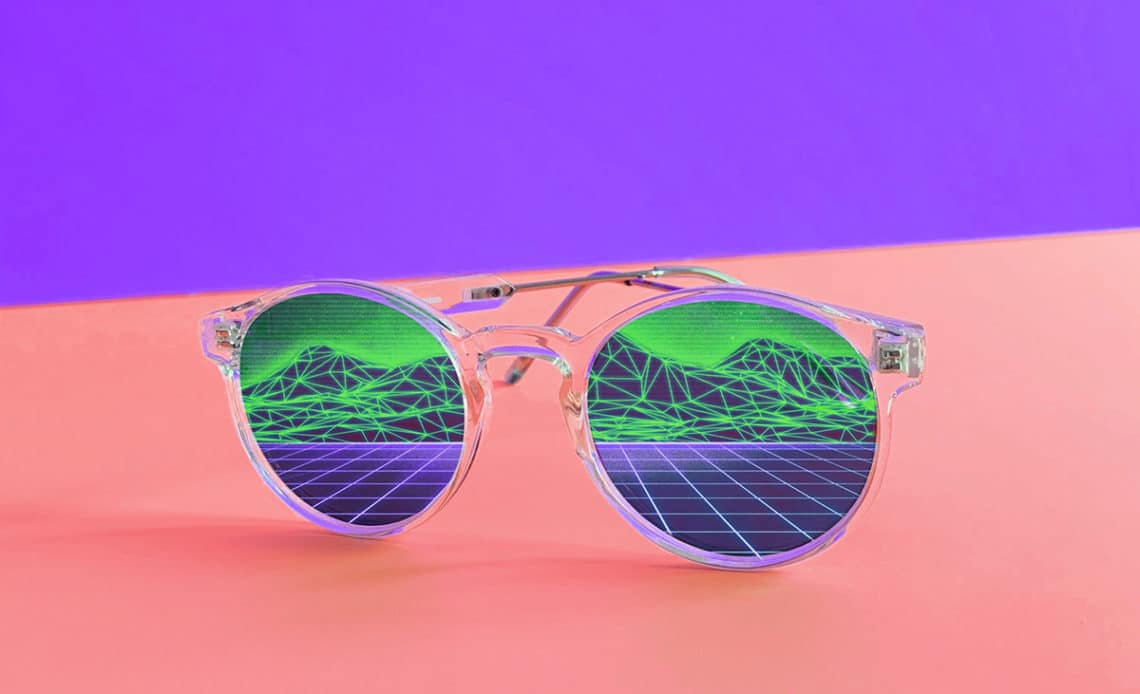
? This is a long read! ? This blue light blocking glasses review goes in-depth on what blue light is all about: how it can mess up your sleep schedule, how it contributes to eye strain, and even why it’s beneficial at certain times of day. We believe that blue light filtering glasses are useful for some issues, but we also think there are products out there—for example, voice-controlled multi-color light bulbs—that can be used in tandem with or as a replacement for blue light filtering glasses. So, below you’ll find recommendations for both. If you want to skip the discussion beforehand, check the table of contents out below.
Do blue light blocking glasses really work? What do blue light glasses do? Why is blue light bad? Is it bad? Most people have by this point heard that blue light affects the brain, and affects sleep, causes headaches… somehow. Of course, the popular science media being what it is, many people are at the point of knowing that blue light is important, but not what they should do with that information.
The underlying reason for the importance of blue light is that it is one of the brain’s main zeitgeibers, or time-givers—things that set our internal clock. According to sleep researcher Dieter Kunz, “Maintaining synchronized circadian rhythms is important to health and well-being. A growing body of evidence suggests that a desynchronization of circadian rhythms may play a role in various tumoral diseases, diabetes, obesity, and depression.”
Light is central to setting our biological clocks. And according to science journalist David Holzman, “although most visible wavelengths can reset the clock, the blues do the job with the greatest efficiency.”
In this article we’ll explain how blue light affects the brain under various circumstances—but we’ll also tell you exactly how to use that information. Equally important, we’ll tell you three things you don’t need to worry about.
Table of Contents
How Does Blue Light Affect Your Brain?
Since blue light is, in nature, primarily seen during the day, you might expect the brain to associate it with daytime, wakefulness, and in general with the sorts of activities and mental states that are common to daytime. And in fact, this is largely what the research shows.
We’ve already seen that blue light raises alertness and overall physiological arousal. As you might have guessed, that also has effects on cognition. Specifically, Alkozei et al found that blue light improves working memory by increasing functional activation of the pre-frontal cortex.
The timing of blue light exposure is important however, and in ways that are often counterintuitive. In the study lead by Dr. Alkozei, blue light exposure took place for 30 minutes before a working memory task and MRI scan. Other studies have shown similar effects of blue light exposure simultaneous to cognition tests.
So far, not too surprising. You’d expect the effects to be strongest at the time blue light is applied, and if blue light has a stimulant effect then it makes sense for it to have an effect when applied before a task; that’s how caffeine and other stimulants work after all.
Blue Light Affects Cognition
What you probably wouldn’t have guessed is that blue light shows benefits when applied after a cognitive task. Not that it improves performance on the previous task—we’re not talking time travel here. Rather, blue light appears to aid learning by enhancing memory consolidation, which takes place roughly 1.5 hours after memory acquisition.
In other words, if you want to learn something more effectively, you’d be well-advised to expose yourself to blue light an hour and a half after studying or practicing it.
Blue Light Acts As A Mild Stimulant
And speaking of caffeine, you might be wondering how the effects of blue light compare to the effects of caffeine. The answer is that they’re similar, but blue light is quite a bit milder.
One study compared one hour of blue light exposure to 240 mg of caffeine– admittedly a very high dose. The study also had one group that got both blue light and caffeine, and a control group that got neither.
In general, blue light and caffeine had similar effects, enhancing alertness, cognition, reaction times, and functional memory. Combining both of them had a stronger, additive effect. Caffeine had a greater impact on subjective energy level, as you might imagine. Additionally, while the cognitive effects of both blue light and caffeine were similar under most conditions, caffeine made subjects more distractible, while blue light didn’t.
In general, blue light acts as a much milder stimulant than caffeine–more like a low dose of rhodiola rosea. That said, the best results would likely have been achieved by combining blue light with a much lower (50-100 mg) dose of caffeine.
As a final note, blue light even affects blind people. It appears that its effects on the brain are exerted via a completely separate neural pathway from the one by which we consciously see light.
“Although most visible wavelengths can reset the clock, the blues do the job with the greatest efficiency.”
How Blue Light Effects Your Circadian Rhythm
Blue light acutely increases alertness and decreases sleepiness, so of course it has effects on your circadian rhythm. As it happens, these effects are sweeping and long-lasting.
In general, blue light exposure during the daytime is good for you, and evening blue light exposure is bad for you. Of course, the devil is in the details.
As far as daytime light exposure is concerned, it seems that the earlier in the day you experience it, the better. Also—at least in the morning—the more you experience, the better. Blue light exposure during the first two hours of the day makes you feel better during the day and fall asleep more easily at night.
Blue light suppresses melatonin secretion, which is part of why it helps you rapidly wake up in the morning. For the same reason, it prevents proper sleep onset at night.
Poor sleep has been conclusively linked to diabetes, and in mouse studies, blue light exposure at night specifically causes pre-diabetes symptoms. Conversely, suppressing blue light at night improves glucose metabolism.
Morning blue light exposure improves mood and cognitive function both acutely and in the long run. Evening blue light exposure impairs mood and cognitive function the next day, but not immediately—in other words, the negative effects stem from lack of sleep rather than a direct effect of blue light, while the positive effects come from a mix of both.
That study linked above additionally notes that Circadian disruption by nighttime light perturbs those processes and is associated with increasing incidence of certain cancers, metabolic dysfunction and mood disorders.
Does Blue Light Cause Eye Strain And Headaches?
Prolonged exposure to excessively bright lights causes eye strain. This presumably includes blue light, but does blue light in particular cause eye strain and headaches, more so than other wavelengths?
The evidence is mixed. Studies on blue light filter glasses show inconsistent and generally weak effects on eye strain.
Logically, you would expect all wavelengths of light to matter from an eye strain standpoint—if you can see them, then your eyes must work to absorb and focus on them, hence they can cause eye strain.
Additionally, eye damage can be caused by ultraviolet light, even though you can’t see it. This is probably at least part of the reason why looking into a very bright artificial light doesn’t seem to hurt as much as looking into the sun.
Of course, you don’t need a study to tell you that bright lights can hurt your eyes–and if it hurts, then you can reasonably assume it’s bad for you.
For now, it looks like the best protection against eye damage is still regular old sunglasses. Well, that and not looking directly at the sun or any other really bright lights.
The Effects Of Blue Light On Jet Lag and Seasonal Disorders
Given what you’ve read, you may have already figured out that blue light can be used to deliberately adjust your circadian rhythm. This has a few uses–fixing jet lag, recovering from a weekend or a night out, or treating seasonal sleep disorders and seasonal affective disorder.
Several studies have found that morning blue light exposure can fix “social jet lag”—the circadian disruptions caused by staying up and sleeping in later on weekends, the having to go back to work the next day or on Monday.
The same technique can be used for literal jet lag; by exposing yourself to blue light first thing in the morning the day after a flight, you can accelerate re-adjustment to your new time zone. This works best if you combine it with 100 mg or so of caffeine, only first thing in the morning.
For added effect, you can also use blue light to start pre-adjusting the day before a flight.
Blue light manipulation is also a critical tool for people who live at extreme latitudes where night time can be only a few hours long, or more than twelve hours long depending on the season.
At extreme latitudes, using blue-enriched light sources to reset one’s circadian rhythm is associated with increased sleep efficiency.
Since poor sleep causes or exacerbates depression, and seasonal affective disorder stems directly from lack of light, blue light is an obvious treatment route for seasonal affective disorder. Guess what: it works.
Blue light therapy is at least as effective as white light in treating SAD, and both are effective. In another study, blue light proved more effective than red light as well as producing better results than many medication therapies had in other studies.
To be clear, researchers did not directly test blue light against drugs in the same study. But since blue light therapy directly addresses the cause of SAD, it’s certainly plausible that it will work better than many drugs.
3 Details You Shouldn’t Get Hung Up On
When the subject of blue light comes up, many people get hung up on two details that, according to the research, just don’t seem to matter.
The first is timing down to the level of hours and minutes. “First thing in the morning” blue light seems to work just fine anytime between a half hour before waking and two hours after. You do not need to rush to go for a walk to get blue light as soon as you get out of bed.
Likewise, while evening light exposure is correlated with poor sleep in non-experimental studies, melatonin secretion actually recovers within 15 minutes of cessation of blue light exposure.
Now this doesn’t quite mean that you’re okay to bombard yourself with blue light up until fifteen minutes before bed–but it does mean that you only need to make a serious effort to block blue light for the last hour or two before bed. It seems like it’s okay to expose yourself to artificial blue light in the early evening, even if that isn’t strictly natural.
When the subject of blue light comes up, many people get hung up on two details that, according to the research, just don’t seem to matter.
The second detail you don’t need to think so much about is wavelengths. There are a lot of studies that try to identify the exact wavelength of blue light that’s responsible for all of these effects in the brain. That’s important from a scientific research standpoint for understanding how the brain works, but that doesn’t mean it matters to you. Remember, not all studies are meant to have immediate practical value to non-scientists.
The reason it doesn’t matter is because blue light isn’t really blue light.
No light is really one color. If light appears blue, it’s actually a mix of colors, with blue merely being the predominant color. Likewise, tinted glasses don’t only block out one highly specific wavelength of light.
That means you don’t need to worry about whether blue light is exactly sky blue, or your blue light filtering glasses are orange vs. amber. “Blue” and “orange” are as specific as you need to get.
The third detail you don’t need to worry about is visible light color as it applies to eye strain. As mentioned earlier, all wavelengths, including UV, can cause eye strain. The solution there is simply less light, and less UV in particular, but not less blue light specifically.
The Best Blue Light Blocking Glasses
What are the best blue light filter glasses? What are the best cheap blue light blocking glasses? Before we get to those questions, it’s important to remember that blue light blocking glasses aren’t the only thing you can do to help with your sleep hygiene and eye strain. Nor is wearing blue light filter glasses the only thing you should do.
Your optimal health in general is not necessarily dependent on a sole factor. Health is a holistic routine full of different variables. So just to take it back to blue light filter glasses, they’re obviously not going to help you sleep if you—for example—don’t stop drinking coffee past 5 PM. Blue light blocking glasses aren’t a magic bullet that way.
That’s why we recommend a number of other strategies and products below our recommendations for blue light blocking glasses. These include regular ol’ sunglasses, orange light bulbs, apps that control your screen brightness, and more. If you really want to get serious about attacking your eye strain or sleeplessness, we strongly encourage you to not only look into blue light filtering glasses, but also into the other products that we list below our recommendations.
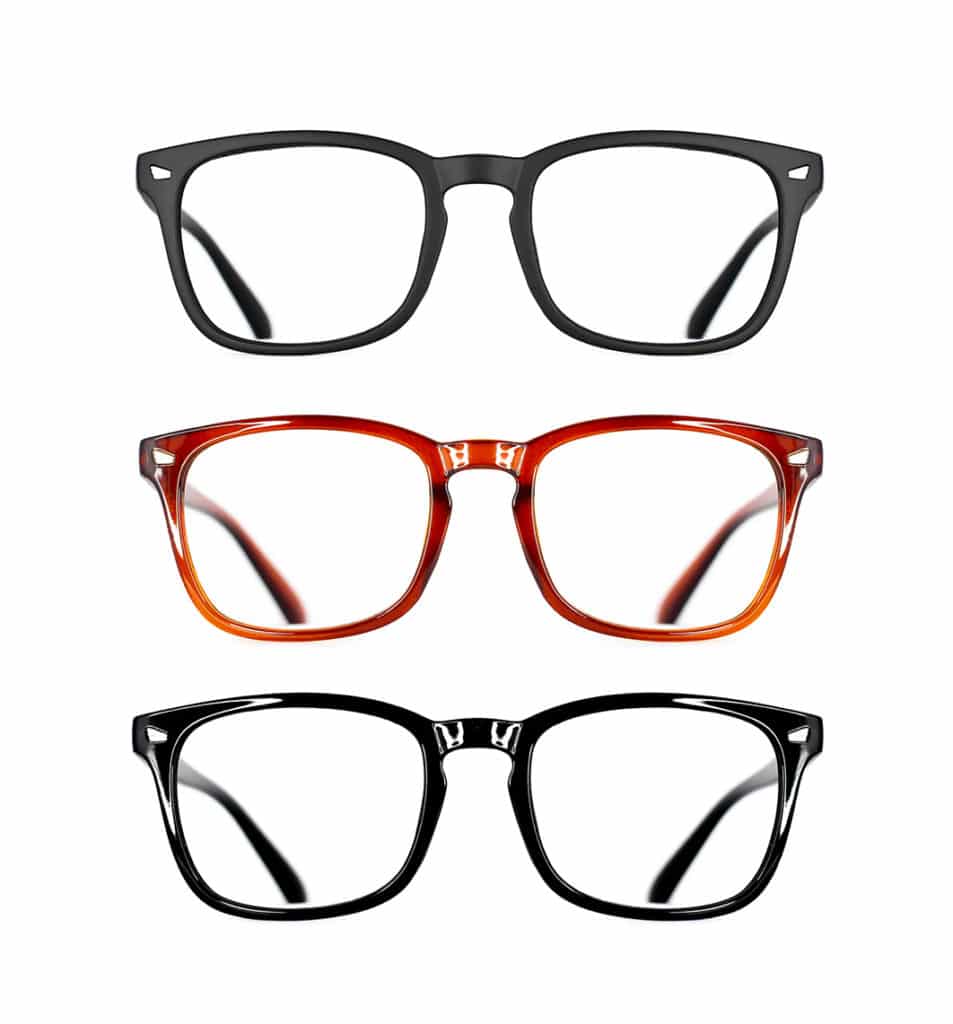
Our recommendation
Kooper Eyewear Hunter + BlueLight
Classic styles for the best value
Kooper sells a range of classic styles at a down-to-earth cost, beating out brands like Warby Parker and Felix Gray—known for their affordability—on bang for your buck. In fact, at $35.99 a pair, Kooper’s frames come at just a quarter of these other brands’ costs. Kooper’s Hunter frames are no-nonsense. They screen out 40% of the blue light that is said to contribute to sleeplessness and eye strain, and 100% of UVA and UVB light. In a space where all clear-lensed blue light blocking glasses are basically the same, it’s hard to argue with Kooper’s offer.
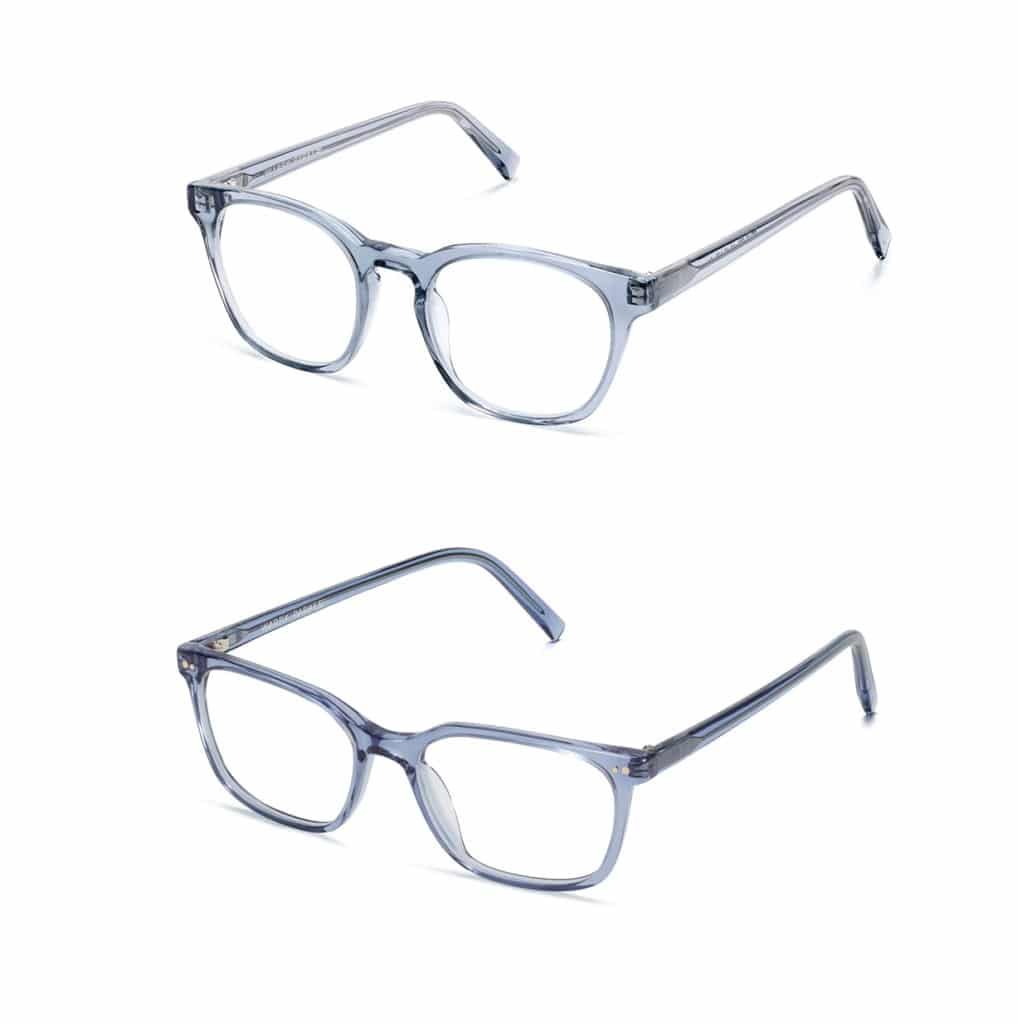
Transition lens technology
Warby Parker Blue Light Glasses: Felix For Men And Weathers For Women
Frames available in multiple colors and widths
These two glasses feature identical technology, differing only in their design. The Weathers glasses are more angular, and both come in several color options. Both come with a very well-made lens case and cleaning cloth. What makes them interesting though is the lens technology. They use light-responsive polycarbonate lenses, which means the lenses automatically darken the brighter the light they’re exposed to. That makes them ideal for situations where you know you’ll be wearing the same glasses in the daytime and well into the evening. IMPORTANT: you must choose blue light lenses when given the option to choose which lenses you want. This will be an extra $50 on top of the $95 for the frames.
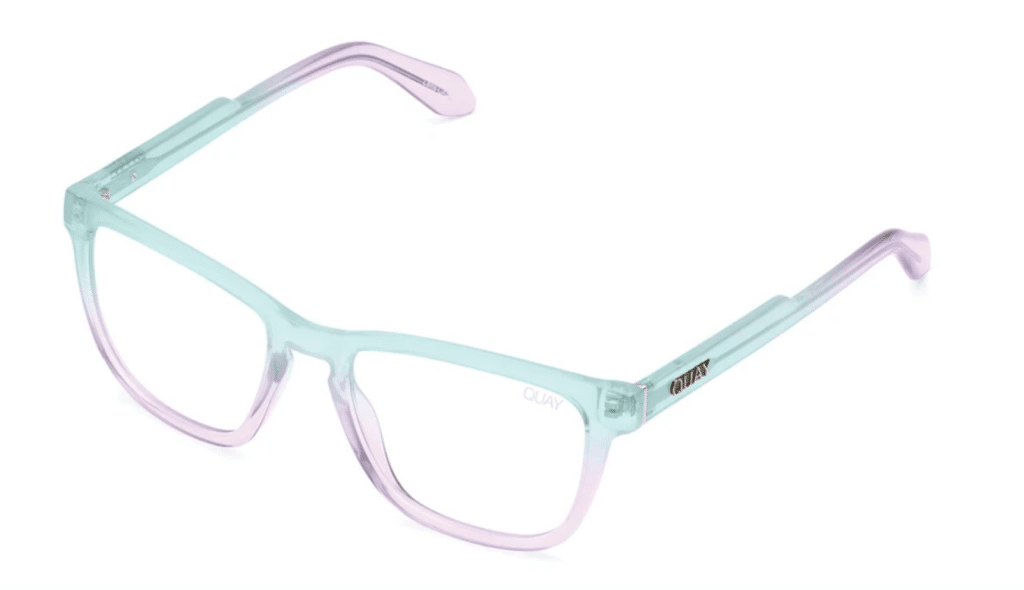
Great value
Quay Hardwire Blue Light Glasses
Frames available in funky colors
With a classic square shape and injection-molded plastic frame, these glasses look more like something you’d wear to a party. Like all Quay glasses, they have a hip, youthful look and that says they’re meant to be worn outside the house. Like the name suggests, these are intended primarily to minimize eye strain when sitting at a computer all day. They don’t really block enough light to be ideal for getting ready to sleep, but they do block enough to protect your eyes without making you tired. And the style makes them perfect if you want glasses you can wear to work all day, and then wear to dinner afterward.
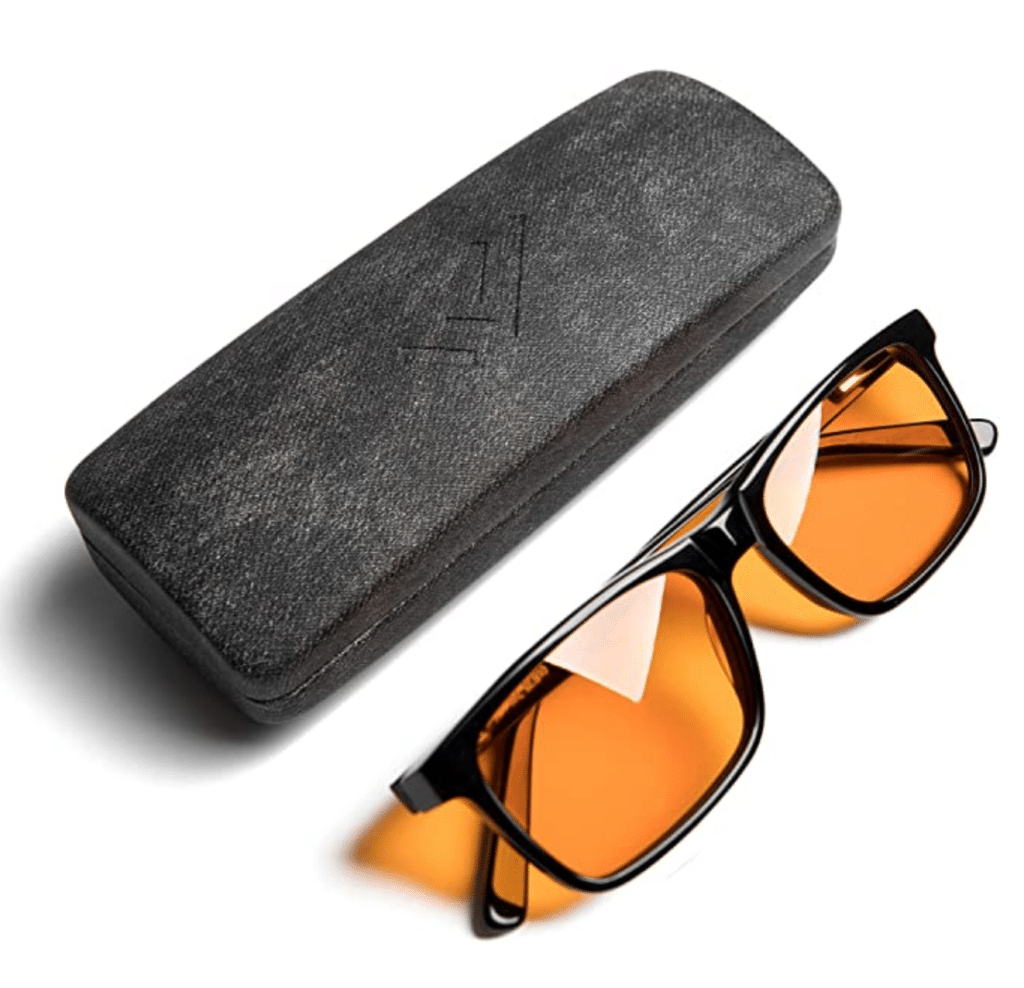
Blue Light Blocking Glasses For Reading
THL Blue Light Blocking Reading Glasses
Available in different strengths—or with no strength
These reading glasses have orange lenses which block a higher proportion of blue and UV light, and a higher proportion of light in general. They’ll definitely make you feel like you’re in a darker room–less light means your brain will be better able to start producing melatonin, so they’re great for later at night. The included case and durable design also makes these an ideal pair of blue-blocker reading glasses for traveling. The overall darkness also makes them ideal for late night situations where excessive light exposure is hard to avoid, such as when flying on a plane and preparing to try to sleep.
Other Blue Light Filter Products That May Be Just As Effective As Blue Light Blocking Glasses
Blue light filter glasses, blue light filtering lenses, blue light filter for PC, etc.
Bearing in mind everything you’ve just read, there are a few types of products that could help you manipulate blue light. You could:
- Reduce the amount of blue light emitted by your computer, phone and other screens
- Reduce the amount of blue light emitted by the lights in your apartment
- Screen blue light out from reaching your eyes
- Restrict light in general from reaching your eyes to reduce eye strain
- Increase blue light exposure during the day
Here we recommend products that are effective for all of those additional strategies.
Red Or Orange Tinted Light Bulbs
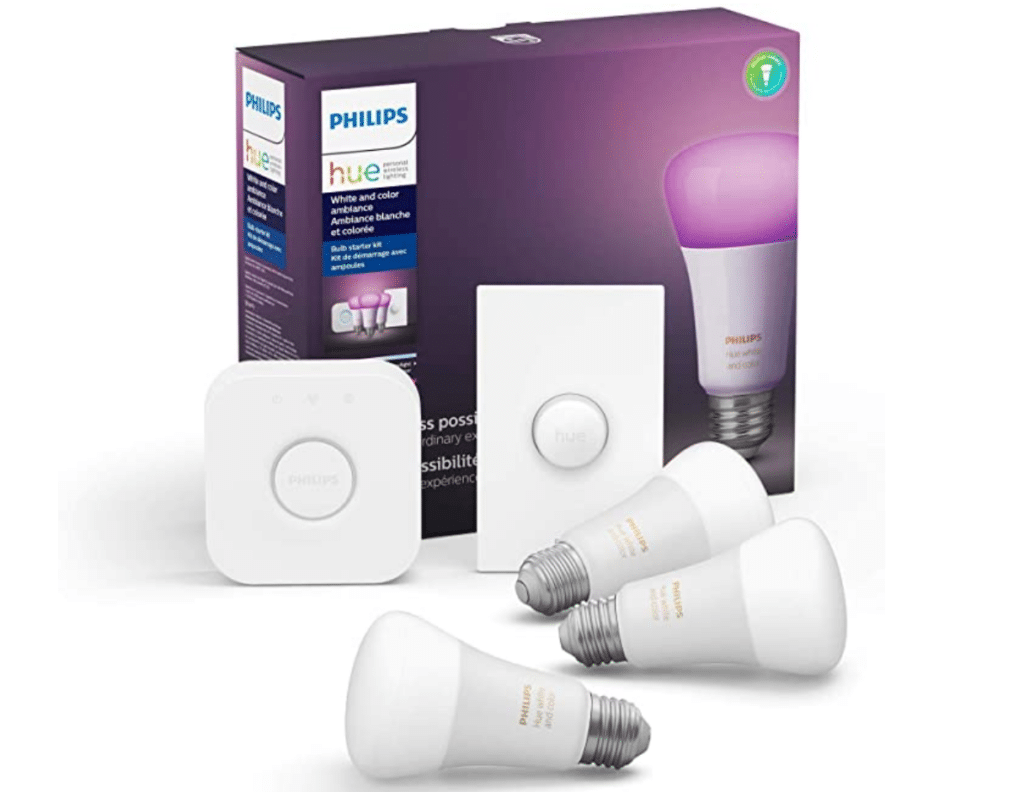
Voice-enabled bulbs that reduce blue light
Philips Hue Color LEDs
Bulbs that change color on voice command
Philips Hue is practically the gold standard when it comes to smart home color bulbs. Install these in your bedroom, living room—wherever—and it’s super easy to voice command the lights to any red or orange as you’re getting ready for sleep.
Alternatively, if you want to get fancy—and make a longer term investment in a smart home system—Philips Hue offers a voice-enabled bulb set that changes colors according to your voice commands.
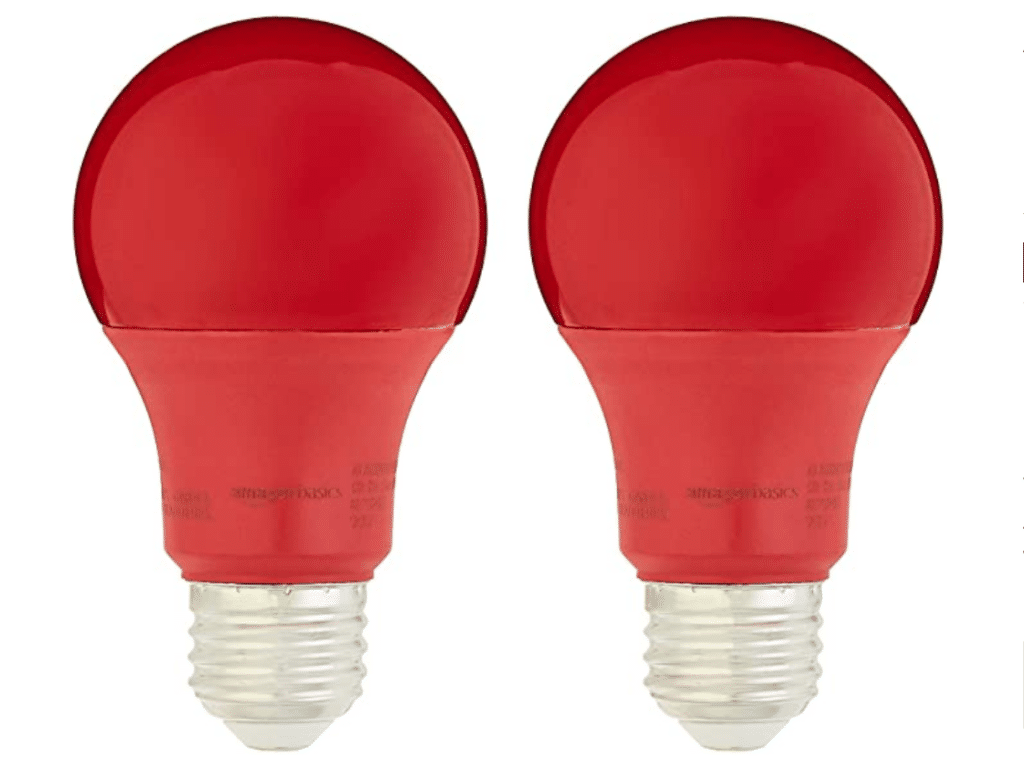
Light bulbs that reduce blue light
Amazon Basics 60W LED Red Light Bulbs
Use in your bedroom before bed
Orange or red light bulbs have a different spectral composition than the normal lights you have in your apartment, and so minimize the amount of blue light you’re exposed to. Best used before bed in your bedroom, any red or orange bulb will allow your brain to secrete melatonin as you’re getting ready for sleep.
This is something that’s rarely discussed, but you can change the spectral composition of the lights in your apartment by using tinted light bulbs. Orange or red light bulbs will minimize blue light and allow your brain to secrete melatonin.
In practice, you probably only want to do this in your bedroom, since you only want to redden the lights at night.
These red light bulbs work well for the purpose. Check sizes and brightness levels however; these are standard-sized light bulbs, and some lamps may use a different type of bulb.
Best Blue Light Filter For PC
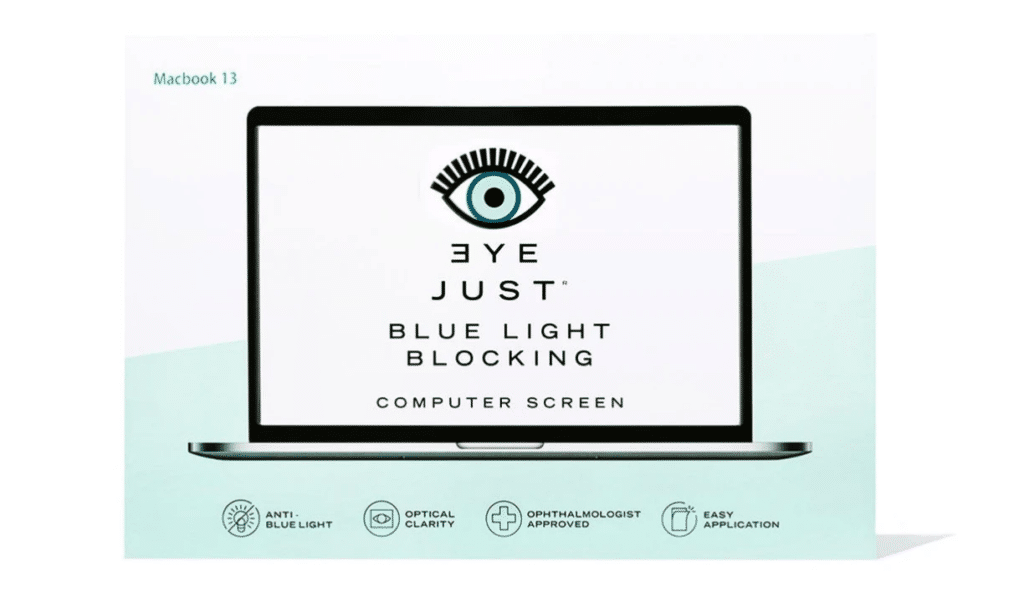
Most trustworthy
EyeJust Blue Light Filter For Mac
Many different sizes
Search for “blue light filter for PC or Mac” on Amazon and you’ll have a pretty hard time sorting through the fakes and frauds. It’s a minefield of sellers with no websites, suspiciously poorly-written product descriptions, and awful graphic design. EyeJust, on the other hand, is a real company, and stands by their claims. They only currently offer blue light filters for Macs.
If you don’t like the look or feel of glasses, and you’re looking for a blue light filter for your computer, you can just add one to your computer screen, tablet, or phone. There are a few products like this on Amazon, but we like EyeJust’s product the best—though it only has filters for Macs, currently.
Orange Glasses Or Goggles For Blocking Blue Light
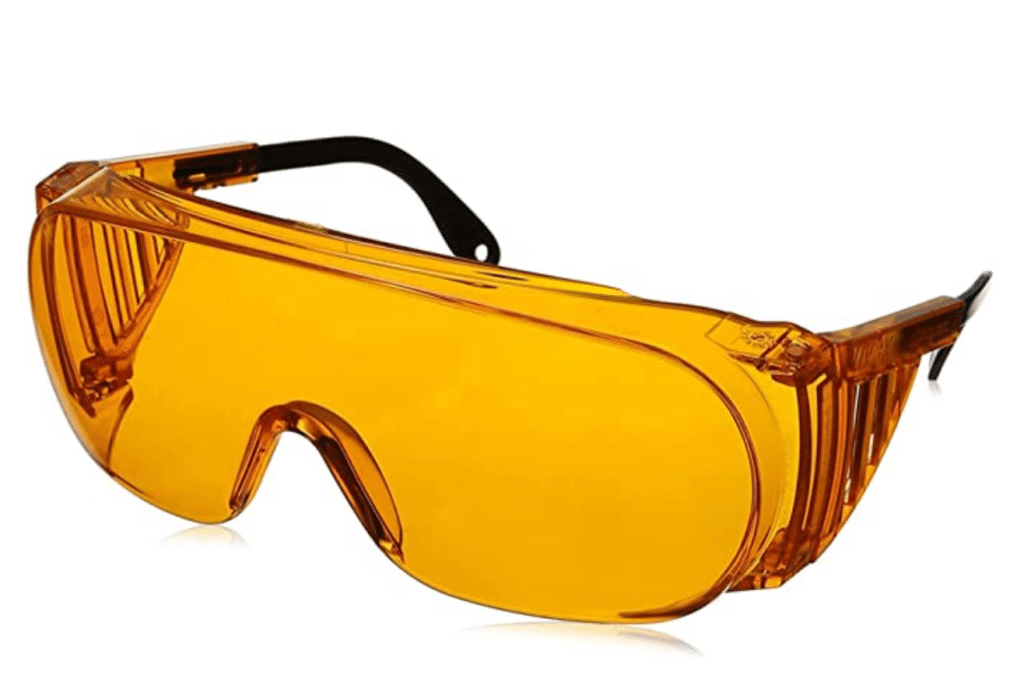
Specifically designed to block blue light before bedtime
Uvex Ultra Blue Light Blocking Glasses
Filters almost all light that can reach your eyes
These Uvex glasses are designed specifically for the purpose, have great coverage, are cheap and durable. They do look and feel a bit like construction goggles though, which can take some getting used to.
Wearing orange or amber-tinted goggles or glasses for the last hour or two before bed is advisable. As mentioned earlier, the exact color isn’t terribly important.
To maximize the effect, you’ll want big glasses that will really cover the eyes. That is, you want almost all light that gets to your eyes to go through the glasses rather than angling around them.
Unfortunately, that means the best glasses probably aren’t going to look cool. Just remember, you’re wearing these at home and in hotel rooms, not when you go out.
These glasses are designed specifically for the purpose, have great coverage, are cheap and durable.
Best Blue Light Filtering Sunglasses
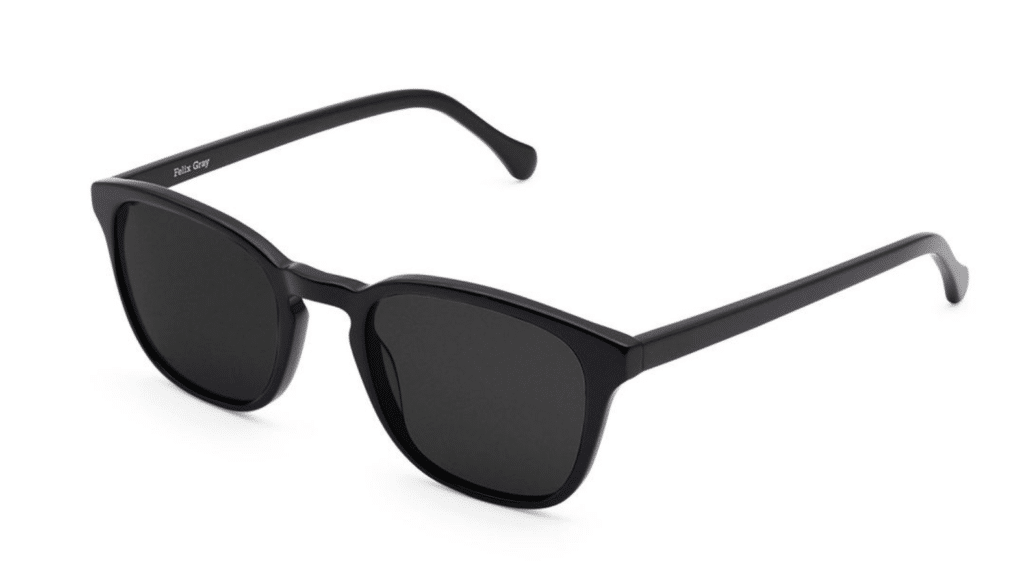
Blue light blocking sunglasses
Felix Gray Blue Light Blocking Sunglasses
Stylish pairs filter blue light and block UV
Sunglasses during the daytime are a great addition to your blue-light-blocking for eye strain and sleep regime. Sunglasses reduce eye strain by limiting the amount of light that reaches the eye, and all Felix Gray lenses block UV light and filter blue light. They’re quite stylish—and affordable—as well.
For preventing eye strain during the day time, regular black-tinted sunglasses are ideal. Unlike blue-blocking glasses, these actually can look cool.
Felix Gray offers tons of great styles at affordable prices, and all their lenses filter blue light, as well as block 100% of UV-A and UV-B light. We’ve picked one of our favorite’s above, but sunglasses frames are always a matter of personal preference. Go to their website and find your favorite.
Devices Nighttime Modes and Blue-Reducing Apps
One idea that’s been around for a while is dimming your screen and tinting it orange at night in order to reduce blue light emissions. The original app for this purpose is f.lux, which is still free.
Many devices, including virtually all phones, now have some of this functionality built in. However in many cases, functions such as Apple’s Night Shift only redden the screen without dimming it overall. This is not enough; the screen needs to be both reddened and dimmed to substantially increase melatonin secretion.
F.lux is still the best solution for your laptop. For your phone, use Night Shift or an equivalent, but manually dim the phone at night if you need to. In both cases, don’t dim it so much you have to strain to read.
Devices For More Blue Light
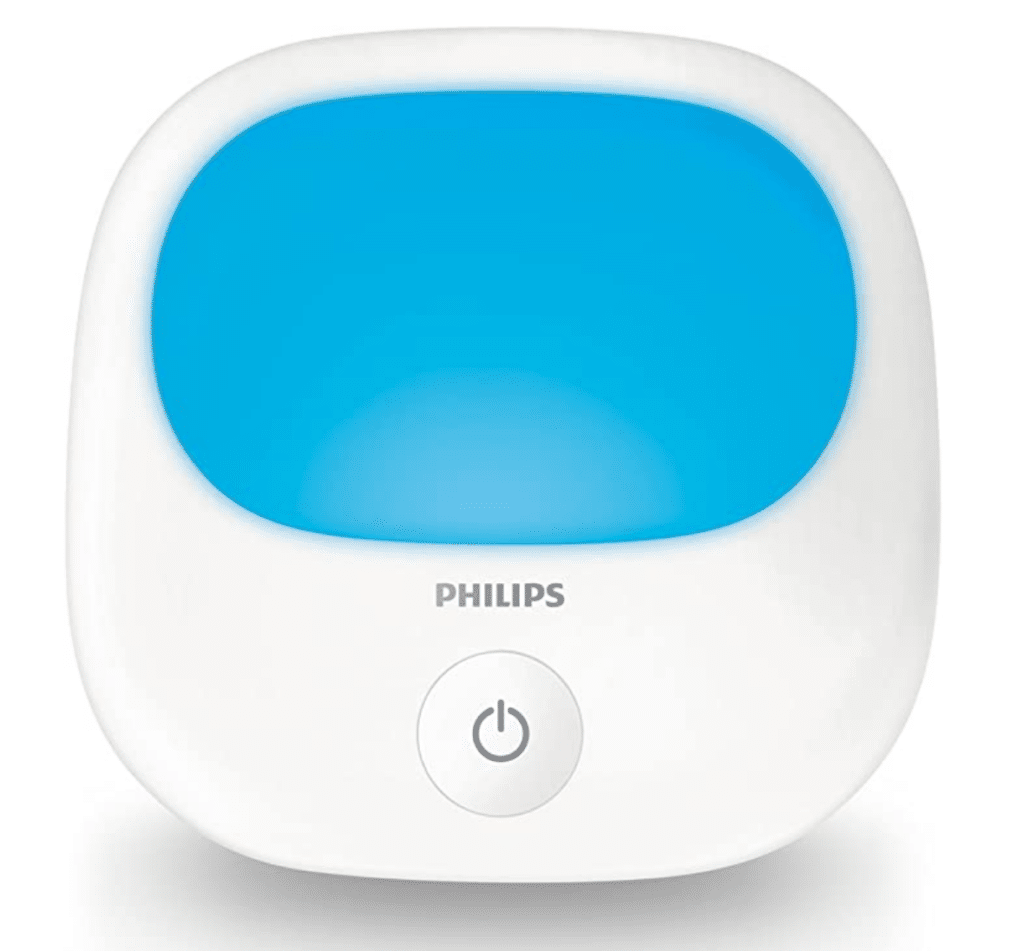
Best Blue Light Device On The Market
Philips GoLite Light Therapy Lamp
100% UV-free blue light
Philips’ specialized blue light device gives you UV-free blue light if you want more of it throughout the day. Remember: blue light before, during, and after working/studying improves mental performance and helps you learn better.
Finally, you want more blue light during the day, especially early in the morning. Going for a walk in the morning is highly advisable of course, but remember: blue light before, during and after working and studying improves mental performance and helps you learn better.
Specialized blue light devices have been developed for the purpose, and the king of blue light devices is the Philips GoLite. There are two distinct ways to use this.
First, set it on your nightstand facing you, with a timer, and use it as a light-based alarm clock to wake you up in the morning.
Second, while working you can set it on your desk and shine it towards your face. Place it 2-3 feet from you, at a 45-degree angle to your face.
Editors note: we are regularly updating this review. If you see any problems, weird interpretations of the data, or just want to say hi, please reach out to hello@the-unwinder.com.